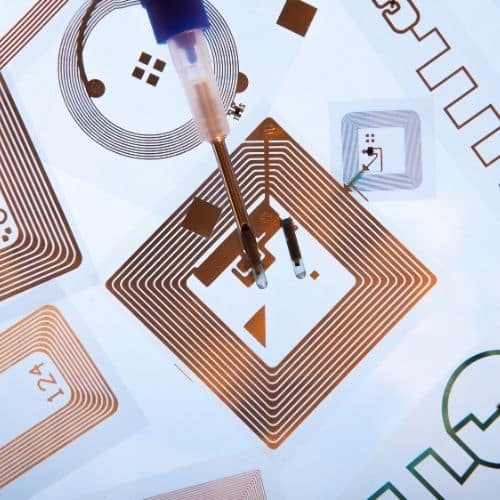Computers and phones have come a long way in the past ten years. This has opened up new possibilities and capabilities in every business-related operation.
Before these developments, fixed asset tracking was likely done on a spreadsheet, if at all. Then, as apps and software grew in their capabilities, software created new fixed asset management capabilities.
There are high levels of automation and improvements when using fixed asset tracking software, as you’re able to create an automated fixed asset register progressively while interacting with your assets, rather than in bulk, off-site, and on a computer.

What Is Fixed Asset Tracking Software?
Fixed asset tracking software is a cloud-based system that allows you to manage your fixed assets on your laptop and on your phone. Effectively, it gives you a full fixed asset register, showing you exactly what your business owns.
Using your app and asset tags, you’ll be able to interact with individual assets and edit unique profiles related to them. This means that you can scan an asset’s tag and report damage against that asset, for example.
All of these edits, whether it’s checking the equipment out, reporting issues, updating location data, or logging routine maintenance are all updated in your fixed asset tracking software automatically. Then, you’ll be able to export a fixed asset register of this data as a spreadsheet or a pdf, ready for the teams, such as accounting or insurance, that need to see it.
How Is RFID Fixed Asset Tracking Software Better?
Conventional fixed asset tracking software will use QR codes and barcodes to allow you to monitor, log, and track your assets. Every time you scan an asset’s tag, for example, your asset tracking system will use your phone’s GPS data to log the asset’s last seen location.
While this is still a vast improvement upon spreadsheets and other out of date systems, depending on your needs, usage, or wants, this can still have limitations.
For example, if you’re tracking high-value assets such as paintings or wine bottles, you won’t be able to stick a visible QR tag onto the asset. This is why companies such as REME are using RFID to track their assets.
RFID tags work with antennas. This means that you can scan tags from a distance with a handheld or fixed RFID reader. Not only does this open up the ability to conceal asset tags, but it also allows you to utilise even more automation.
Handheld RFID Equipment Tracking
Handheld RFID readers are able to speed up conventional asset tagging features. Firstly, not needing to search for a tag on an asset and use your phone to scan it can save you a couple of moments, but the ability to pick up radio-frequencies opens up much more.
For example, one of itemit’s features is Quick-Add. In itemit, you’re able to create physical locations as well as use last-seen location tracking. Then, if multiple assets are moving to a new location in bulk, you’ll be able to scan the assets’ tags in bulk. With QR code asset management, this will require a line-of-sight. With handheld RFID equipment tracking, however, it just requires you to pull the trigger on your reader.
In a similar way, you’ll be able to utilise an auditing feature. This works by clicking “audit” in your location’s profile, then you’ll be able to scan your assets’ tags to verify that they still exist in that location. With RFID asset tracking, again, it’s just a simple case of pulling the trigger.
Fixed RFID Asset Tracking
Fixed RFID asset tracking is the next level, and it’s the future of equipment tracking. Handheld RFID asset tracking still needs a level of manual input. However, fixed RFID equipment tracking can totally automate your location tracking.
This is highly effective in busy environments, such as in a healthcare setting, as with fixed RFID asset tracking, you only need to set up your system and that’s it.
itemit is unique as it provides you with an off-the-shelf fixed RFID system that is easy to set up and start using. How it works is that when an asset moves from one location to another, a fixed RFID reader will pick up on this movement, as well as the direction, and either assign or unassign your asset from the location it’s moving to or from.
Overall, both of these capabilities give you more speed, more automation, and more control over your fixed assets. This means that you’re able to gain a higher level of accuracy, avoiding ghost and zombie assets, while inputting less than half the work!
To find out more about how itemit’s RFID fixed asset tracking software can help your business, you’ll be able to contact us at team@itemit.com. You can also fill in the form below to start your 14-day free trial. Contact us today if you’re interested in RFID!

Try itemit
Choose a better way to track your assets. Start your free 14-day trial now!

Keep Learning
itemit Blog
Tips, guides, industry best practices, and news.
Why Hospitals Need To Use Equipment Management Tools
Why exactly do hospitals everywhere need to use an equipment management system/tool? Read our latest post now to find out!
Save Money On Equipment Maintenance: 5 Tips
Saving money on equipment maintenance is never easy. Read this post now to discover how pre-emptive maintenance can help!
Equipment Tracking Software Is Here to Stay: Find Out Why
Many businesses all over the globe use equipment tracking software. Read this article now to find out why you should too!


